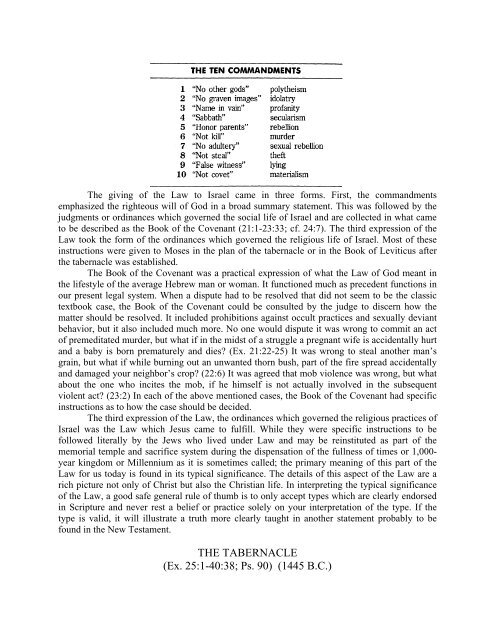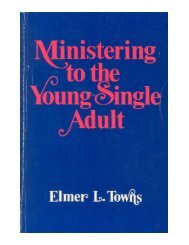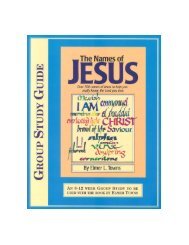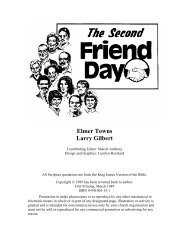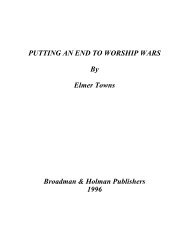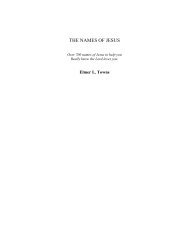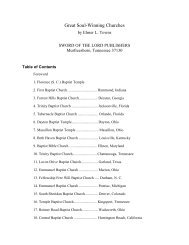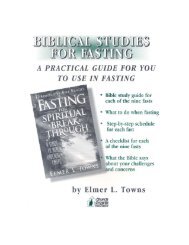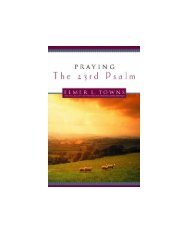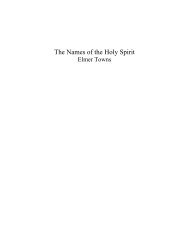A Journey Through The Old Testament - Elmer Towns
A Journey Through The Old Testament - Elmer Towns
A Journey Through The Old Testament - Elmer Towns
Create successful ePaper yourself
Turn your PDF publications into a flip-book with our unique Google optimized e-Paper software.
<strong>The</strong> giving of the Law to Israel came in three forms. First, the commandments<br />
emphasized the righteous will of God in a broad summary statement. This was followed by the<br />
judgments or ordinances which governed the social life of Israel and are collected in what came<br />
to be described as the Book of the Covenant (21:1-23:33; cf. 24:7). <strong>The</strong> third expression of the<br />
Law took the form of the ordinances which governed the religious life of Israel. Most of these<br />
instructions were given to Moses in the plan of the tabernacle or in the Book of Leviticus after<br />
the tabernacle was established.<br />
<strong>The</strong> Book of the Covenant was a practical expression of what the Law of God meant in<br />
the lifestyle of the average Hebrew man or woman. It functioned much as precedent functions in<br />
our present legal system. When a dispute had to be resolved that did not seem to be the classic<br />
textbook case, the Book of the Covenant could be consulted by the judge to discern how the<br />
matter should be resolved. It included prohibitions against occult practices and sexually deviant<br />
behavior, but it also included much more. No one would dispute it was wrong to commit an act<br />
of premeditated murder, but what if in the midst of a struggle a pregnant wife is accidentally hurt<br />
and a baby is born prematurely and dies? (Ex. 21:22-25) It was wrong to steal another man’s<br />
grain, but what if while burning out an unwanted thorn bush, part of the fire spread accidentally<br />
and damaged your neighbor’s crop? (22:6) It was agreed that mob violence was wrong, but what<br />
about the one who incites the mob, if he himself is not actually involved in the subsequent<br />
violent act? (23:2) In each of the above mentioned cases, the Book of the Covenant had specific<br />
instructions as to how the case should be decided.<br />
<strong>The</strong> third expression of the Law, the ordinances which governed the religious practices of<br />
Israel was the Law which Jesus came to fulfill. While they were specific instructions to be<br />
followed literally by the Jews who lived under Law and may be reinstituted as part of the<br />
memorial temple and sacrifice system during the dispensation of the fullness of times or 1,000year<br />
kingdom or Millennium as it is sometimes called; the primary meaning of this part of the<br />
Law for us today is found in its typical significance. <strong>The</strong> details of this aspect of the Law are a<br />
rich picture not only of Christ but also the Christian life. In interpreting the typical significance<br />
of the Law, a good safe general rule of thumb is to only accept types which are clearly endorsed<br />
in Scripture and never rest a belief or practice solely on your interpretation of the type. If the<br />
type is valid, it will illustrate a truth more clearly taught in another statement probably to be<br />
found in the New <strong>Testament</strong>.<br />
THE TABERNACLE<br />
(Ex. 25:1-40:38; Ps. 90) (1445 B.C.)


